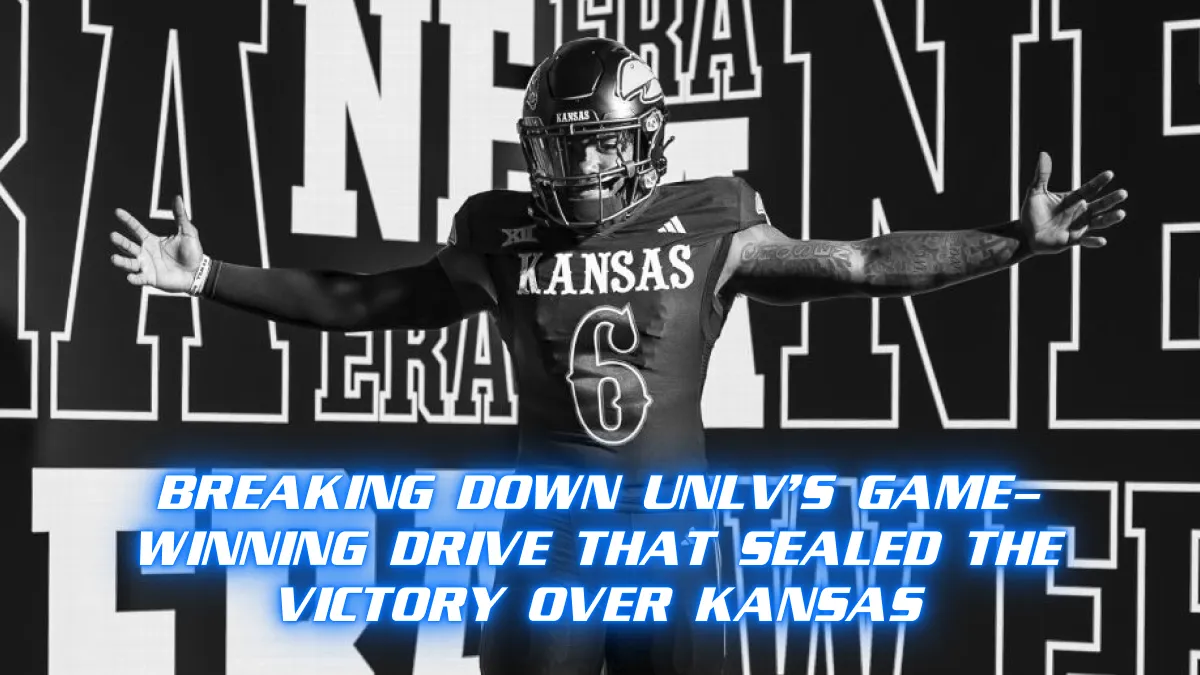The Kansas Jayhawks’ defense has been formidable this season, but for the second consecutive week, they faltered late in the game. After Illinois managed a game-clinching 6:46 drive last week, UNLV replicated that formula with a lengthy 18-play drive that lasted 9:22, culminating in the decisive touchdown. Despite a solid performance for most of the game, Kansas couldn’t stop UNLV’s offense when it mattered most. Here’s an in-depth look at how UNLV executed their game-winning drive.
Key Moments in UNLV’s Game-Winning Drive
The drive began with Kansas in a position to potentially turn the game in their favor early. On the second play of the drive, UNLV quarterback Matthew Sluka was pressured into an errant throw that could have been intercepted. Kansas safety OJ Burroughs made an impressive play on the ball, but his feet barely touched the sideline, nullifying the turnover.
The missed opportunity forced UNLV into a third-and-nine, giving Kansas a chance to get off the field early. However, Sluka, who was the Rebels’ leading rusher, executed a perfectly timed quarterback draw, finding a gap in the Kansas defense for a 21-yard gain and a first down. This critical play not only kept the drive alive but also shifted momentum in UNLV’s favor.
Missed Opportunities and Defensive Breakdowns
Kansas’ defense had several opportunities to turn the tide during this drive. On the very next play, Jereme Robinson stripped Sluka from behind, knocking the ball free. Unfortunately, multiple Kansas players failed to recover the fumble. Burroughs attempted to scoop up the loose ball but fumbled his chance, allowing UNLV to retain possession.
Robinson commented on the missed opportunity, stating, “I knew the quarterback was a little careless with the ball… we just have to be better about scooping it and scoring it.” This moment proved to be one of several costly mistakes that allowed UNLV to continue marching down the field.
Another critical play came on a second-and-10 with 8:06 remaining. Kansas defenders had a chance to stop Sluka at the line of scrimmage, but the quarterback broke free for a 10-yard gain, moving the Rebels closer to scoring territory. With Kansas linebackers dropping back into coverage, the defense struggled to contain Sluka’s mobility.
Costly Penalties and Crucial Conversions
As the drive progressed, UNLV found themselves in a precarious situation. On a second down, Sluka, under heavy pressure, launched a desperate pass into the end zone. The ball was severely underthrown, but Kansas’ Devin Dye was flagged for pass interference after shoving UNLV’s Casey Cain. This penalty moved the ball to the Kansas 11-yard line, setting UNLV up in prime scoring position with just over seven minutes remaining.
Kansas managed to hold UNLV on two consecutive plays, leaving the Rebels with a third-and-three at the four-yard line. After a key stop by Cornell Wheeler, the Jayhawks forced a fourth-and-one. However, UNLV converted the fourth down with a quarterback sneak, and though an unnecessary roughness penalty moved them back 15 yards, the drive continued.
UNLV capitalized on confusion surrounding the down and distance, with Kansas unable to stop the drive from progressing. Despite the penalty, UNLV managed to convert a first-and-goal from the three-yard line.
The Decisive Touchdown
As time ticked away, the Kansas defense initially responded well, forcing UNLV backward on first and second down. A tackle for loss by Tommy Dunn and a key stop by Dylan Wudke put the Rebels in a third-and-goal situation from the 12-yard line. Once again, Sluka’s mobility proved to be the difference. He scrambled for 11 yards, setting up another fourth-and-one. With 2:00 left on the clock, Kylin James powered into the end zone, giving UNLV a 23-20 lead.
Jereme Robinson summed up the defense’s frustration: “Sluka definitely made a play on us in the red zone… we just need to figure out how to tackle him better and knock him down.”
Kansas’ Last Chance
Despite UNLV’s score, Kansas still had an opportunity to win the game. With 1:51 remaining, the Jayhawks’ offense took the field down by three. However, they couldn’t establish any rhythm and failed to move the ball into scoring position. UNLV’s final drive not only ended with a touchdown but also drained the clock, giving Kansas little time to respond.
The Rebels dominated the time of possession on this last drive, getting into Kansas territory at the 9:24 mark and holding the ball until the two-minute warning. The Kansas defense, which had limited UNLV to just 2-of-13 on third downs throughout the game, allowed the Rebels to go 3-for-3 on fourth down conversions during this crucial series.
Conclusion: UNLV’s Resilience Seals the Win
In the end, it was UNLV’s ability to execute in the critical moments that made the difference. While the Kansas defense played well for much of the game, they were unable to make the necessary stops when it mattered most. Sluka’s mobility, coupled with Kansas’ missed opportunities and penalties, led to UNLV’s game-winning drive.
For Kansas, this game was a painful reminder of the importance of closing out games. Despite a solid defensive performance for much of the contest, the Jayhawks were unable to stop UNLV when it mattered, allowing the Rebels to secure a come-from-behind victory.
As Kansas moves forward, they’ll need to address their struggles in the fourth quarter to avoid similar outcomes in future matchups. Meanwhile, UNLV will look to build on their success, knowing they can rely on their resilience and ability to capitalize on key opportunities to win close games.

















